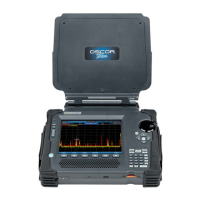OPERATION
31
reference level to the default, press the OK button and select Default Range from the context
menu that pops up. This will also reset the dBm/div value to default.
4. dBm/div indicator – indicates the number of dBm per screen division. The dBm/div value can
be adjusted by tapping twice on the dBm/div indicator with the stylus and selecting a new value
from the drop down list. To reset the dBm/div value to the default, press the OK button and
select Default Range from the context menu that pops up. This will also reset the reference
level to default.
5. Cursor Value – indicates the cursor frequency position
6. Cursor – dotted vertical line. A small arrow indicates the power level at the current cursor
position. The value is displayed just above the arrow.
7. Legend – indicates which traces are currently displayed on the screen and identifies the color of
each trace. Sweep counts are not shown in this screenshot, but can be displayed in the legend
(see page 27).
8. Menu Options – Menu options are displayed along the bottom edge of the screen.
Navigating the Spectral Display
The OSCOR unit is capable of scanning and displaying a large portion of the RF spectrum. In order to
fully analyze the RF energy in a given location, it may be necessary to focus on smaller portions of the RF
spectrum at a time. This can be accomplished by using one of several available methods:
- Center on Cursor: If your spectral display is not currently set to maximum span and your cursor
is not at the center of the spectrum, press the OK button and select Center on Cursor from the
context menu that pops up. The OSCOR display will move the frequency of the current cursor
position to the center of the display. The OSCOR will not change the span of the display, so if
the span is near the maximum and the cursor is too far off center, then the OSCOR will only
position the cursor frequency as close to center as possible without changing the span. Note: If
no context menu appears when OK is pressed, tap the spectral display with the stylus or your
finger and then press OK again.
- Click & Drag - Pan: If your spectral display is not currently set to maximum span, clicking on the
right side of the spectral display with the stylus or your finger and dragging to the left will pan
the spectral display to higher frequencies. Clicking on the left side of the spectral display with
the stylus or your finger and dragging to the right will pan the spectral display to lower
frequencies. Your SPAN parameter will remain constant, but your START, STOP, and CENTER
parameters along with the CURSOR position will change as the spectral display pans.
- Arrow Keys – Pan: If your spectral display is not currently set to maximum span, pressing the
RIGHT ARROW key will jump up one half screen to the next set of higher frequencies. Pressing

